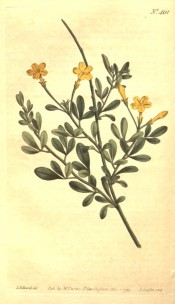Jasminum fruticans L.
Frost hardy, dense, upright, evergreen or semi-evergreen shrub with alternate, pinnate leaves composed of 3 leaflets, and terminal cymes of up to 5 salverform, slightly fragrant yellow flowers, to 1.5cm across, in summer. To 1.5m by 1.5m. [RHSE, Hortus].
Horticultural & Botanical History
‘The yellow jasmine is often planted against walls, pales, etc. as the branches are weak and slender and it will grow to be ten or twelve feet high if thus supported; it may however be planted in shrubbery quarters, to which it is better suited than the White Jasmine. The young shoots are of a fine strong green colour, angular, and a little hairy. The leaves are trifoliate, though sometimes they grow singly. They are placed alternately on the branches, are of a thick consistence, smooth, and of a fine deep green colour. These leaves in well-sheltered places remain until the spring before they fall off, so that this plant may not improperly be planted among the Evergreens, especially as the young shoots are always of a strong green. The flowers are yellow, and do not possess the fragrance of the common Jasmine. They are produced chiefly in June, and the blow is soon over. They are succeeded by berries, which when ripe are black, whence its name of Berry-bearing Jasmine. Although this shrub possesses a certain stiffness, which gives it somewhat the appearance of an artificial flower, yet the fine yellow colour of its blossoms contrasts so well with the rich green of the foliage, that in the flower-pot or bouquet it never fails to have a conspicuous and pleasing effect.
Is a native of the South of Europe and the Levant, was cultivated by Mr. John Gerard, in 1597, and flowers from May to October. Is easily propagated by suckers or layers; as the flowers have no scent, is not so much cultivated as formerly.’ [BM t.461/1799].
History at Camden Park
Listed in all published catalogues [T.593/1843].
Notes
Published Jan 20, 2010 - 10:50 AM | Last updated Jan 20, 2010 - 10:56 AM
| Family | Oleaceae |
|---|---|
| Category | |
| Region of origin | Portugal, North Africa to Turkmenistan |
| Synonyms | |
| Common Name | |
| Name in the Camden Park Record |
Jasminum fruticans - Yellow Jasmin |
| Confidence level | high |


